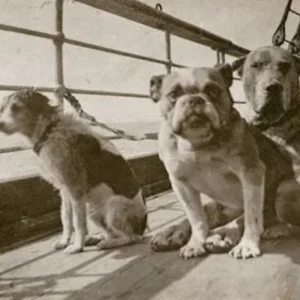Our ancestors were in shock 112 years ago. How could the RMS Titanic, the engineering marvel of its age, a ship designed with such exacting care that it was proclaimed “unsinkable,” be lost on its maiden voyage?
There was also the staggering human cost. Folks in 1912 had difficulty grasping the enormous loss of life. Some 1,500 souls perished, making it the worst single-ship maritime disaster up to that time.
But more than humans perished that frigid April night. Lost amid the telling and retelling of Titanic’s story is the fate of its lesser-known passengers. Many tales are factual, some cannot be confirmed, and a few others are just too good to be true, which is to be expected from a catastrophe of such epic proportions.
Let’s start with what we know for sure. At least three dogs escaped in lifeboats: two Pomeranians and one Pekingese show champion, Sun Yat Sen. Their escape was a big deal because, with so many passengers and so little space in the lifeboats, crew members refused to let animals go with their owners. It’s believed all three owners spared their beloved pooches by smuggling them inside their cabins because they were so small, later hiding them inside thick winter coats as they fled the ship.
Twelve larger dogs kept in kennels weren’t so lucky. Ironically, their owners had planned a dog show for the morning of April 15 — the same day as the sinking. Just before Titanic slipped beneath the waves, someone opened the cage doors, and toward the end, dogs were excitedly running along the increasingly slanting decks. At least one dog was spotted furiously swimming away from the ship.
Millionaire John Jacob Astor was last seen on the deck with his favorite Airedale faithfully at his side. A woman point-blank refused to get into a lifeboat since her big dog (either a Great Dane or a St. Bernard; witnesses’ memories differed) couldn’t go with her.
(A side note: A wealthy Washington, D.C., resident was importing 100 hounds for English-style fox hunting in the United States. He originally planned to ship them on the Titanic, but a last-minute change of plans put them on another ship.)
Then there were the cats. Oceangoing vessels often kept a few cats onboard. Titanic is known to have carried a cat named Jenny, who did double duty as mascot and mouser. She had transferred over from Titanic’s sister ship, RMS Olympic, made herself comfortable in the new ship’s galley, and promptly delivered a litter of kittens there. (More on her in a minute.)
Also aboard the doomed ship were four roosters and hens imported from France. New York socialite Ella B. Holmes had planned to breed them. Incidentally, widowed at age 40, Holmes spent the rest of her days traveling with piano teacher Marie Grice Young, whose students included President Teddy Roosevelt’s children.
And let’s not forget the rodents. Nobody knows how many rats and mice made the crossing. But none survived its abrupt ending.
Which brings us back to Jenny the cat. A heartwarming tale about her makes the rounds on the internet every so often. It claims that sensing disaster ahead, she carefully carried her young kittens off the ship when it stopped in Southampton, England. Her friend and provider, Jimmy, a galley hand, saw what she was doing and, prompted by her feline foreboding, also departed the Titanic before it sailed off to its destiny. Thus, Jenny was responsible for saving her own life, her babies, and her human pal.
A moving story, to be sure. Except it didn’t happen.
Violet Jessup, a stewardess who survived and lived until 1971, later remembered how the cat “laid her family near Jim, the scullion, whose approval she always sought and who always gave her warm devotion.”
Jim didn’t make it. Neither did Jenny.
Yet, the story sails on from generation to generation as more than a century later, people desperately search for a silver lining amid the still haunting loss of the Ship of Dreams.





